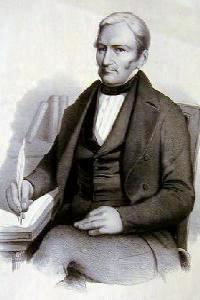Icaria
Ikarien (French: Icarie ) is the name of an island state in the utopian novel Voyage en Icarie ( Journey to Icaria ) by the early socialist Étienne Cabet . The movement that formed against this background referred to itself as the Icarians . The attempt to put the utopia into practice in America was also called Icaria.
The utopian novel
The content of Cabet's book was based on the ideas of Robert Owen , with whom the author had personal contact. In addition, there were the writings and ideas of Filippo Buonarroti and François Noël Babeuf , but also Utopia by Thomas More . Voyage en Icarie was first published in France in 1840 and had five editions by 1848. It was widespread among the workers.
The book tells the fictional story of an English lord who reached the island of Icaria on a journey. Shortly before, a revolution had brought about a transition to democratic communism . The state is a well-organized workers state, the top priority of which is complete equality and community of property.
The Icarian Movement
The novel was a tremendous success and Cabet became the focus of a political movement based on the novel ideas. In 1847 he had about 400,000 followers in France. Their goal was to turn the utopia into reality. Collections were organized for this purpose. Since Cabet assumed that the transition to communism could only take place voluntarily, the Icarians were to create model cities in order to convince more and more people of their ideal of community of property through practice. In consultation with Robert Owen, Cabet decided on Texas as the first location of an ikari settlement. Land has already been acquired from Europe. In 1848, Cabet published his appeal “Allons en Icarie!” Due to the emergence of the second republic after the February Revolution , it seemed at times that social changes would also take place in France itself. Therefore, the appeal was barely effective. Only 69 people joined a first group of settlers. The settlement they founded in Texas failed for various reasons and numerous settlers died of cholera . They then returned to New Orleans, where in the meantime Cabet had also arrived with about 300 other settlers.
The failure of utopia
In 1849, the settlers bought an almost urban settlement called Nauvoo on the Mississippi River in Illinois from the Mormons who moved to Utah . In addition to residential houses, there was also a mill and a distillery. In the first seven years or so the experiment seemed to work and schools and theaters were built. Letters from German Icarians from 1848 to 1864, which are preserved in the Hamburg State Library, report on life in the colony. Accordingly, in the settlement, which probably never had more than 500 residents, there were quite progressive facilities such as kindergarten, infirmary, laundry, pharmacy, etc., while similar things in the rural area of Illinois were rather the exception. A Sunday university, which was devoted to cultural and scientific subjects, made possible a cultural life in the colony.
After just a few years there was a dispute between the settlers and Cabet over the use of the scarce resources available. Cabet, who is described as very needy and domineering, always thought in larger or universal dimensions, such as the creation of an Ikarian US state, while the settlers tried to maintain their colony economically. In addition, Cabet had developed into a dictatorial leader who intervened in the private lives of the settlers. In addition, the settlement was dependent on financial support from France, which dried up more and more after 1848, so that the debt increased.
In 1856 a split broke out over dissatisfaction with Cabet's dictatorial tendencies. When a new leadership was formed in 1853, Cabet refused to recognize it and demanded that the community be dissolved. Instead, he was expelled. He then left the settlement with his supporters and died a short time later in St. Louis .
Although the colonists had farms and modern businesses such as a sawmill, a steam mill and a small flotilla for fishing, it went bankrupt in 1857. Until 1895, for example, there were various attempts to establish communities according to the Ikari model, which ultimately failed.
In 1889 Gerhart Hauptmann mentioned in his social drama Before Sunrise the settlement projects of the Icarians in the USA through the person of the social reform-minded Alfred Loth.
literature
- Etienne Cabet: Journey to Icaria . With materials for understanding Cabet compiled by Alexander Brandenburg and Ahlrich Meyer , translated by Dr. Wendel-Hipper (pseudonym for Hermann Ewerbeck) (= library of utopias ). Kramer, Berlin 1979, ISBN 3-87956-114-1 (the volume contains a reprint of the Paris, Bureau du Populaire, 1848 edition).
- The time - time runs, May 19, 2004
- Dorothea Schuler: "To Icaria, brothers, to Icaria!" Robert Owen, Etienne Cabet, Giovanno Rossi: Experiments for a better society . In: Joachim Meißner, Dorothee Meyer-Kahrweg, Hans Sarkowicz (Ed.): Lived Utopias. Alternative life plans . Insel, Frankfurt am Main and Leipzig 2001, ISBN 3-458-17086-3 , pp. 117-137.
- Uwe Timm : Icaria. Kiepenheuer & Witsch, Cologne 2017, ISBN 978-3-462-05048-6 (novel with reference to both title and subject to Étienne Cabet).
Web links
- Icarians in the New World
- Richard Saage: Utopian Communism (PDF file; 99 kB)
- National Icarian Heritage Society ( February 27, 2008 memento in the Internet Archive )
- Excerpts from "The Journey to Icaria"
- The communist. Organ of the Icarische Gütergemeinschaft (1854-1855) in full text ( Memento from November 24, 2006 in the Internet Archive )
Individual evidence
- ↑ Gerhart Hauptmann: Before sunrise. Social drama . Reclam, Stuttgart 2017, p. 52, 157 f .

